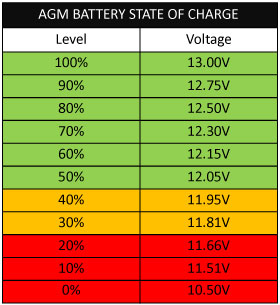Mccaf
Adventurist
Go read up on this subject on my website.
-- The D250S/SmartPass combo works well because it combines an intelligent relay with the voltage boost of a B2B.
-- Less expensive? Well, I like the Blue Sea ACR, but then you would have to spring for a solar controller. And, if your voltage really stays below 14v, some form of voltage adjustment device, about $100 for something plug and play.
Given that you already have the D250S and solar panels, your best bet might well be to simply add the SmartPass.
Some notes about voltage as a means of determining state of charge (aka SOC). There are lots of charts, like this one, that will give you a guesstimated state of charge from the battery voltage.

But they are generally not very accurate because they only work with resting voltage, that is the voltage of the battery about two hours AFTER being disconnected from either a charge source or a load:
-- When connected to a charger, the voltage at the battery terminals is generally that of the charge source. (Unless the load is much greater than the charge.)
-- Disconnected from a charger, but under load, the voltage will be drawn down by the load. Lights or even a small refrigerator won't matter much, put a hair dryer or microwave on there and even a large battery bank will show an appallingly low voltage.
Sooooo, if your batteries were at 12.7v when you started, then they were "fully" charged. If they now show 13.2v, connected to the solar controller with sunlight on the panels (expect about 5A for every 100w of panel in good sun), then they have probably completed the absorb stage and are floating nicely.
If you are really concerned, and you probably should be if you have a large battery bank, call it larger than 200Ah, then you are in the market for a real battery monitor. But that too is another, long discussion. But remember, it is less important that YOU know the state of charge and more important that your electrical system know it and respond correctly.
With lead acid batteries, time is your friend and that means that you want as much solar as you can cram on there.
Final note: Charging lead acid batteries is not something that you decide to do, or start or stop. The old statement, "I need to idle the engine for a few minutes to "top off" the batteries." is a prescription for turning expensive batteries into paper weights. You want a system that puts the batteries on charge automatically, every time there is even a single ray of sun or that your engine is running. And no, you will never run your engine long enough to fully charge your batteries. A full charge requires shore power or solar. Fortunately, you already have the latter and it will make all of the difference.
Can you point me to your write up specifically? Thanks
So according to the chart above, I was at about 40% when I left the desert. Two hr drive home with the fridge running off the house battery, and it only went up to just over 12volts, iirc12.10. Is that normal? For the amount of charge from the alternator?
